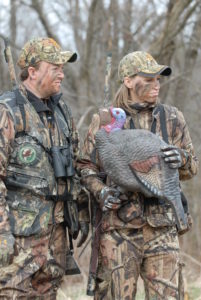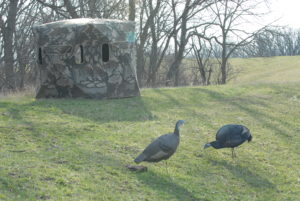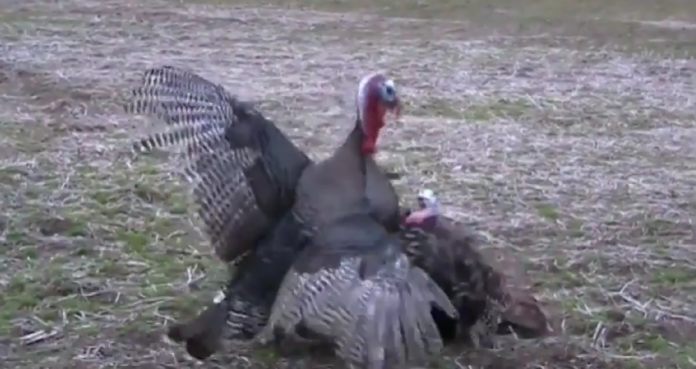This Turkey is Not Happy
& The Art of Turkey Hunting: A Comprehensive Guide
At this writing, I’m still laughing at this video, yet it makes a number of powerful points about turkey hunting. The first, and perhaps the most powerful, point is that a realistic turkey decoy works much better than a standard plastic model. Real feathers help dramatically, with a real turkey fan being the most important.
Here’s the video: Jake smashes turkey decoy
The Power of Realistic Decoys
Consider “Stuffers,” as they are known in the turkey hunting community. Plastic decoys do the job decently, but real feathers work best. One way to create a realistic wild turkey decoy is to have one mounted by a taxidermist. A high-quality one will cost up to $500, and one vendor sells out each year at the National Wild Turkey Federation Convention.
If you enjoy do-it-yourself project

s, you can mount your own using borax to tan the skin. If you skin the turkey carefully, you may be able to convince a local taxidermist to do a “quickie mount” for a significant discount. The tail is the most crucial part, and mounting a real turkey fan to a plastic decoy can make a world of difference. The sight of a turkey fan in a gobbler’s territory usually prompts an immediate attack, regardless of what lies underneath. For a step-by-step guide on how to create your own turkey scrapes, check out our detailed article here.
The Advantage of Blind Hunting
This video doesn’t show the blind, yet it demonstrates how close a wild turkey will approach. The incoming gobbler is a jake (a one-year-old gobbler). It pays zero attention to the blind, and you can actually hear the hunter and camera operator talking as it stands nearby. If you are a bowhunter, this setup can provide you with the kind of point-blank range that’s most effective. For more on this topic, check out our previous article by outdoor writer & turkey whisperer Jason Ashe, “Gearing Up for Spring Gobblers: Roosting Techniques for Silent Gobblers”.
The Role of Jake Decoys in Turkey Hunting

Most wild turkeys have no fear of hunting blinds. Jake decoys prompt the most aggression by gobblers and are often ignored by hens. For these reasons, many hunters prefer them. However, if you want that standing shot at a gobbler that’s strutting perfectly still, the jake won’t deliver it. Gobblers usually attack jakes, as you will see, whereas they will strut and stand perfectly still in front of a hen. One strategy is to use a hen and a jake so that you get the attraction and the stillness. For more insights into the role of decoys, read our article “Gearing up for Spring Gobblers: Preview the Breakup”.
Preparing for the Hunt
Now that we’ve discussed the importance of realistic decoys, it’s crucial to remember the importance of preparation. Pre-season scouting is an essential part of a successful turkey hunt. Check out our article, “Now’s the Time to Scout for Spring Turkeys” for tips and tricks to improve your scouting skills.
The Art of Calling in Turkeys
One of the most thrilling aspects of turkey hunting is calling in a turkey. Knowing how to use a call effectively can greatly increase your chances of a successful hunt. Our article, “How to Have Success Calling in a Turkey This Spring”, provides valuable insight into this topic.
Turkey Hunting in Different Weather Conditions
It’s also important to understand how weather conditions can affect turkey behavior and, ultimately, your hunt. Our article, “Perfect’ Gobbling Weather”, discusses how to make the most of your hunt in varying weather conditions.
Understanding Turkey Behavior
Turkeys have excellent vision and hearing. They can see movement and colors very well, so you need to stay still and wear camouflaged clothing. Turkeys also communicate using a variety of calls. Learning these calls and using a turkey call can help attract turkeys.
It’s worth noting that the timing of the turkey breeding season, which largely influences hunting season, is primarily governed by the length of daylight hours. However, changing climatic conditions, such as warmer temperatures, could have an impact. For instance, if warmer temperatures result in the early availability of food sources, turkeys might be in better physical condition and start breeding earlier.
Late Season Turkey Hunting
Towards the end of the season, it’s vital to adapt your strategies for late season turkey hunting. For strategies specific to this time, read our article “5 Ways to Kill a Late Season Turkey”.
Final Thoughts
Remember, hunting success can vary greatly depending on local conditions, turkey behavior, and a bit of luck. It often takes time and experience to become proficient at turkey hunting. The art of turkey hunting is a combination of patience, strategy, and understanding of turkey behavior.
Here’s the Video on FB: Turkey smashes decoy



















![The Best Deer Camp Chili [VIDEO] Deer Chili Ingredients, Tomatoes, Chili Spices](/wp-content/uploads/2015/10/Deer-Chili-Deer-Camp-Recipe-218x150.jpg)
![How to Call Elk Early in the Season [VIDEO]](/wp-content/uploads/2016/08/byers003-218x150.jpg)




![Idiots Disturb Hunter: How Would You Have Handled It? [VIDEO]](/wp-content/uploads/2015/10/DSC00110-e1474487693878-100x70.jpg)
![Albino Buck Shocked to Shed His Antlers [VIDEO]](/wp-content/uploads/2015/10/AlbinoDeer-100x70.jpg)